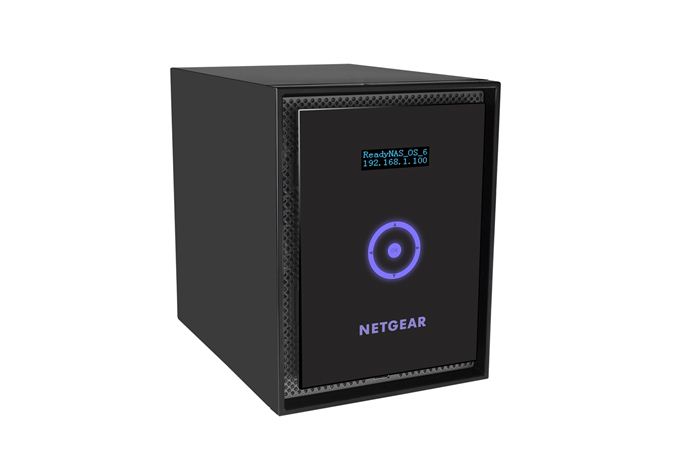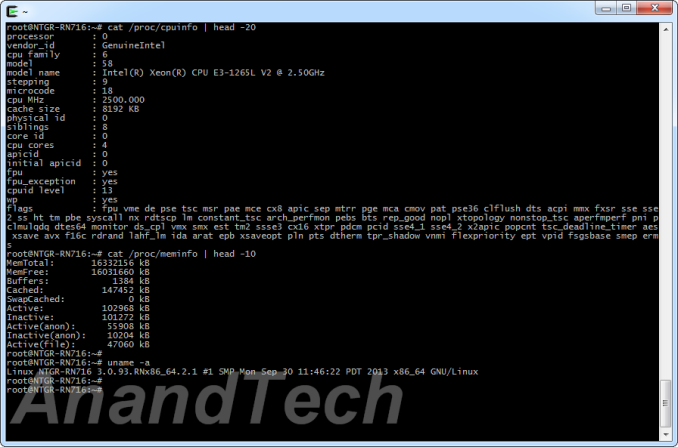Netgear Launches ReadyNAS 716 6-bay 10-GbE Desktop NAS
by Ganesh T S on November 18, 2013 11:01 AM EST- Posted in
- NAS
- IT Computing
- NetGear
- ReadyNAS

We reviewed the ReadyNAS 312 (one of the entry-level members) in Netgear's x86 NAS lineup last week. Netgear's ReadyNAS introductions this year were covered earlier in March. Today, Netgear is expanding the lineup based on ReadyNAS OS 6.x with the 6-bay RN716x.
10 GbE capabilities have been restricted to rackmount units so far, but we are seeing vendors slowly recognize the scope for those capabilities in the desktop / tower form-factor. QNAP launched its TS-x70 series last month and touted its 10 GbE-readiness. By default, those units come with dual GbE cards in the expansion slot making for a total of four GbE ports in each unit. Netgear is going one step further with the RN716 by bundling a dual 10 GbE card in the expansion slot along with the two GbE ports already on the motherboard.
The ReadyNAS RN716 is based on an Intel Xeon x86 platform and comes with ECC DRAM making it a full-fledge server solution for business and enterprise users. The following table presents the detailed specifications of the RN716x.
| Netgear ReadyNAS 716 Specifications | |
| Processor | Intel Xeon E3-1265L V2 (4C/8T, 2.5 GHz) |
| RAM | 16 GB ECC DDR3 RAM |
| Drive Bays | 6x 3.5"/2.5" SATA 6 Gbps HDD / SSD (Hot-swappable) |
| Network Links | 2x 1 GbE + 2x 10 GbE |
| USB Slots | 2x USB 3.0 / 3x USB 2.0 |
| eSATA Slots | 3x (compatible with EDA500 expansion chassis) |
| Expansion Slots | 1x (occupied by 2x 10 GbE card, not user-replaceable) |
| VGA / Display Out | HDMI |
Similar to all other ReadyNAS units based on ReadyNAS 0S 6.x, the RN716 also runs a Linux kernel with a btrfs file system for the internal storage volumes. We have been experimenting with a review unit in-house over the last week. A full review is coming in later this month, but here are some other interesting aspects of the platform as revealed after gaining SSH access to the unit.
Unlike other 10 GbE units we have seen so far, the RN716 comes with 10GBase-T connections. These go well with the full 10GBase-T switches introduced by Netgear earlier this year. In fact, we are reviewing the RN716x bundled with a Netgear XS712T in our labs right now. The RN716x is expected to retail around $3000.











10 Comments
View All Comments
The Von Matrices - Monday, November 18, 2013 - link
It's a step forward, but I am still looking for cheaper 10GBase-T equipment. I want <$40 network cards and <$300 switches. It seems like 10GBase-T is taking forever to reach this market. The wired networking market had stagnated so much that we're almost at the point where wireless is faster than gigabit ethernet.IanCutress - Monday, November 18, 2013 - link
Agreed. The Netgear switch is still £610 last time I checked (with limited availability), and cards can vary a bit but the cheapest are £200/port. Crazy.DanNeely - Monday, November 18, 2013 - link
The first company that will let me link my main desktop and my NAS at 10gb for $400-500 will be getting a fist full of my money.otherwise - Tuesday, November 19, 2013 - link
If you're willing to roll your own, a linux based NAS distro should be able to support infiniband; and there is plenty of used Infiniband equipment at that price point.Freakie - Monday, November 18, 2013 - link
Don't forget that most 10Base-T switches are using SFP connectors too. Even though 10GbE is becoming more popular, over half the equipment out there is using SFP instead of RJ45 which is still crap news for consumers.mdgm - Monday, November 18, 2013 - link
NetGear sells some 10G switches with RJ45 connectors such as the 8-port XS708E (I think that was the cheapest last I looked).mtoma - Friday, November 22, 2013 - link
What about Thunderbolt 2 connectivity? It should be cheaper and future-proof. And, the things are moving along quite rapidly there.Mithan - Tuesday, November 26, 2013 - link
I agree, but we have not had a use for it until now. I expect the next few years will bring the demand needed to cause it to support the market.James5mith - Monday, November 18, 2013 - link
Infiniband is 3x cheaper than 10GbE for the small-scale. Not sure why a 40Gb technology is so much more "consumer" price friendly vs. 10GbE.daniel142005 - Sunday, January 5, 2014 - link
Was wondering that the other day... what exactly is holding 10GbE from being so cheap? The components? I don't know much about how a network card's electronics work, but why not slap an ARM chip on it and make it more software based? Isn't that essentially what the Killer NIC did? (might not have been ARM, but same concept)